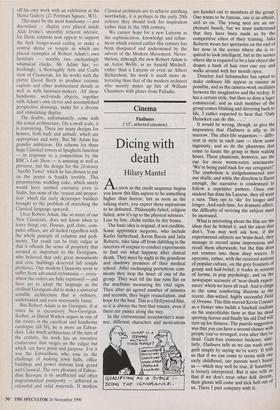Cinema
Flatliners ('15', selected cinemas) Dicing with
death
Hilary Mantel
As soon as the credit sequence begins you know this film aspires to be something higher than horror; but as soon as the talking starts, you expect these aspirations to be defeated. 'Philosophy failed, religion failed, now it's up to the physical sciences.' Line by line, cliché rattles its dry bones.
The basic idea is original, if not credible. Some apprentice surgeons, who include Kiefer Sutherland, Kevin Bacon and Julia Roberts, take time off from dabbling in the interiors of corpses to conduct experiments to find out what happens after clinical death. They meet by night in the grandiose and shadowy premises of their medical school. After exchanging portentous com- ments they stop the heart of one of the group. They wait till the line runs flat on the machines measuring his vital signs. Then after an agreed number of minutes and seconds, they begin resuscitation, and hope for the best. This is a Hollywood film, so it is always the best that ensues, even if there are panics along the way.
In the conventional screenwriter's man- ner, different characters and motivations are handed out to members of the group. One wants to be famous, one is an atheist, and so on. The young men are an un- pleasant bunch, but we must understand that they have been made so by the competitive ethos of their training. Julia Roberts wears her spectacles on the end of her nose in the scenes where she is re- quired to look intelligent, but in the scenes where she is required to be a lust object she drapes a hank of hair over one eye and walks around with her mouth open.
Director Joel Schumacher has opted to make ordinary life appear as sinister as possible, and so the camera-work oscillates between the imaginative and the tricksy. It has a certain style, but then so does a lager commercial; and as each member of the group comes blinking and shivering back to life, I rather expected to hear that 'Only Heineken can do this. . .
It would be wrong, though, to give the impression that Flatliners is silly to its marrow. The after-life sequences — diffe- rent in style in each case — show some ingenuity, and so do the phantoms that come to haunt the group in their waking hours. These phantoms, however, are the cue for more worm-eaten sentiments: 'We're being paid back for our arrogance!' The symbolism is sledgehammered into our skulls; and while the direction is fluent enough, the narrative is condemned to follow a repetitive pattern. Once one student has done his Lazarus, they all want a turn. They opt to 'die' for longer and longer. And each time, for dramatic effect, the difficulty of reviving the subject must be increased.
What is interesting about the film are the ideas that lie behind it, and the ideas that don't. You may well ask how, if the experimental subjects are brain-dead, they manage to record sense impressions and recall them afterwards; but the film does not venture into these deep waters. It operates, rather, with the received notions of popular culture, on the grey frontiers of gossip and half-belief; it trades in notions of karma, in pop psychology, and on the newspaper accounts of 'near-death experi- ences' which we have all read. And it clings to the same comforting illusions as the recent, dim-witted, highly successful Field of Dreams. This film starred Kevin Costner as a farmer who builds a baseball stadium on his unprofitable farm so that his dead sporting heroes and finally his old Dad will turn up for fixtures. The puerile suggestion was that you can have a second chance with people you've wronged, even after they re dead. Guilt-free existence beckons; simi- larly, Flatliners tells us we can wash away guilt simply by saying we're sorry. It tells us that if we can come to terms with our early childhood, our parents won't haunt us — which may well be true, if 'haunting is loosely interpreted. But it also tells us that if we don't treat other folk decent, their ghosts will come and kick hell out of us. There I part company with it.


































































 Previous page
Previous page